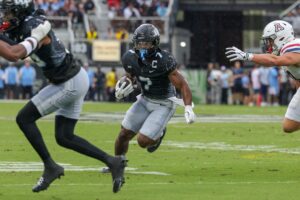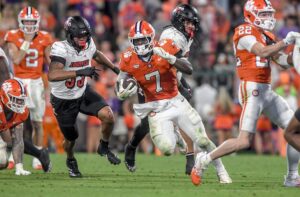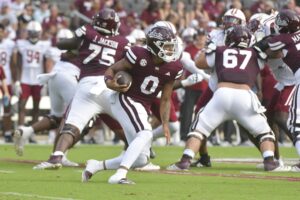As we look at the decade that was for LSU, we broke it down into two segments. We already looked at the first half of the decade. The second half of the 2010’s found LSU still trying to halt its decline. The loss in the game for the 2011 national title continued to haunt the program, especially Les Miles. More disappointment and failures awaited them before returning to glory and exceeding the remarkable accomplishments of the 2011 squad.
2015
LSU started out 7-0. The Tigers held off a fourth quarter rally at Mississippi State, survived at Syracuse and outlasted Florida. LSU hosted South Carolina due to extensive flooding near Columbia.
As they headed to Tuscaloosa, the Tigers were ranked in College Football Playoff. Leonard Fournette was the odds-on favorite for the Heisman Trophy. After trailing 13-10 at halftime, the defense allowed 17 straight points. The defeat caused a nose-dive with losses to Arkansas and Ole Miss.
Rumors of Miles’ impending termination raged during the week of the regular season finale. The Tigers trailed 7-6 at halftime. Derrius Guice and Fournette each scored a touchdown in the second half to secure victory over Texas A&M. Miles’ players carried him off the field. Despite the speculation, athletic director Joe Aleva announced that Miles would remain the head coach.
2016
A lackluster performance in the season-opener versus Wisconsin ended the NCAA record winning streak in regular season non-conference games. The Tigers escaped with a three-point win over Mississippi State. At Auburn, the replay official nullified the apparent game-winning touchdown since the game clock had expired.
That was the latest in a series of last-second flops and near-escapes during era of the Mad Hatter. That blunder ended Miles’ tenure.
Ed Orgeron became head coach. Orgeron fired offensive coordinator Cam Cameron then elevated Steve Ensminger into that position. That decision sparked the Tigers’ offense for that season and into the future.
The change invigorated LSU’s players. The Tigers dominated Missouri and Southern Mississippi. Tied at 21 at halftime, the Bayou Bengals outscored Ole Miss, 17-0. The grudge match with Alabama was scoreless after three quarters and not settled until late in the fourth quarter. The game with Florida ended in a heartbreaking loss. Fournette left the team after the victory at Texas A&M.
LSU settled for a trip to the Citrus Bowl to face Louisville and Heisman-winning quarterback Lamar Jackson. Guice compiled 149 yards from scrimmage and scored two touchdowns. The Cardinals’ offense had averaged scoring more than 40 points per game. LSU limited Louisville to only three field goals. The tumultuous season had a satisfying conclusion.
2017
The Tigers suffered their most lopsided loss to Mississippi State in the 113 games of the series. A three-point loss to Troy ended the NCAA record for consecutive non-conference home game wins. They rebounded to upset Florida and Auburn in consecutive weeks. Their struggles continued against Alabama, losing 24-10. LSU landed at the same post-season destination. The year ended on a sour note as Notre Dame notched the game-winning touchdown in final two minutes.
2018
The Tigers upset Miami, ranked in the top ten of both major pre-season polls, in the season-opener. They started 5-0 before heading to Gainesville. Joe Burrow threw a pick-six with less than two minutes left in the game that sewed up the decision for the Gators. LSU responded by trouncing number two-ranked Georgia.
The build-up to hosting Alabama soared over two weeks. However, the Tide ground out a lead of 22-0 midway through the third quarter. LSU did not threaten to score until the fourth quarter and failed to do so.
Once again, LSU slumped through November. The Tigers nearly blew a 24-3 lead after three quarters at Fayetteville. Controversial calls by the officials in College Station extended the game to an NCAA-record seven overtime periods with the Tigers losing, 74-72.
Despite the late-season decline, LSU appeared in the Fiesta Bowl against Central Florida. UCF drove to the endzone on its initial possession then returned an interception for a touchdown. Burrow shook off a blindside block after throwing the interception. He directed the Bayou Bengals to pay dirt on the next three possessions to grab the lead which they never relinquished. LSU finished 10-3 and ranked sixth in the Associated Press’ final poll and seventh in the coaches’ last poll.
2019
LSU entered the season as the sixth ranked team in both major polls. Whispers out of spring practices and fall camp hinted at an offensive renaissance. Joe Brady and Steve Ensminger were constructing a juggernaut.
The Bayou Bengals showed in the second game, at Texas, that their offensive mindset had changed. Starting with the ball on their 42 yard line and 1:07 left in the first half, Burrow completed three straight passes. That final one counted for a touchdown. Later, clinging to a lead of 37-31 with less than three minutes in the game, LSU’s offense faced third down and 17 on its own 39 yard line. Burrow connected with Justin Jefferson who outraced Texas’ defensive backs. LSU emerged as the victor of a match-up of teams ranked in the top ten.
The offense continued to pile up yards and points in eight consecutive wins. LSU outlasted two top-ten opponents, Florida and Auburn, after being tied with both at halftime. LSU headed into its open date with Alabama up next.
In Tuscaloosa, the Bayou Bengals scored during six of their eight possessions in the first half, including two touchdowns in the final 30 seconds for a 33-13 advantage. Meanwhile, the defense gave up only one touchdown in the first half. Although Alabama scored touchdowns on the Tide’s final four possessions, LSU emerged victorious.
The path to the SEC Championship Game lay wide open. LSU’s offense raced to a 31-7 halftime lead at Ole Miss then held off the Rebels. The Tigers took a 28-6 lead over Arkansas into halftime then added three more touchdowns. Against Texas A&M, the Tigers sprinted to scores on their first five possessions and a 31-0 domination at halftime. LSU routed the Aggies, 50-7.
LSU made its first appearance in the SEC Championship Game in eight seasons. Georgia, featuring the top-rated overall defense in the country, seemed like an imposing obstacle. Instead, Burrow, Grant Delpit, Ja’Marr Chase and the offensive line made their final statements for the multiple awards that would be later bestowed on them. The offense rolled to the endzone twice in both the first and third quarters. The defense held the Bulldogs to just a field goal through three quarters.
The College Football Playoff committee designated LSU as the top seed. Burrow and his offensive colleagues justified their accolades. The Tigers steamrolled the Sooners to the count of 484 yards and 49 points in the first half. LSU outclassed Oklahoma, 63-28.
LSU returned to where its football program began to decline: the Superdome. Early in the game, it appeared that LSU had met its match. Clemson accomplished two feats that no other team had: preventing LSU from scoring on its first three possessions and taking a lead by double-digits.
In response, Burrow and his offense shifted into high gear. He, along with Chase and Thaddeus Moss, scored touchdowns on their last three possessions of the first half. The Purple and Gold defense clamped down on Clemson, allowing just one more touchdown. Burrow and crew added a touchdown in each of the final two quarters to secure the national championship.
Conclusion
During the seasons of 2010s, the Fighting Tigers had an overall record of 103-28. LSU won at least eight games per season. They had a record of 7-4 in bowls. They finished 60-23 versus opponents from the SEC. LSU won two SEC championships.
The 2019 squad purged the bitterness lingering from the national championship game of the 2011 season. Ed Orgeron had directed the most successful LSU team and one of the greatest in the history of college football. LSU ended the decade atop the summit of college football with a view of a promising future ahead.






